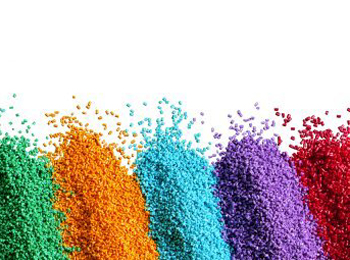First Off, What is a Color Masterbatch?
Color masterbatch can be described as a concentrated blend of additives or pigments that are created by various heating procedures that involve the compression or encapsulation of the concentrate within a carrier resin.
Color masterbatch finds widespread use in a vast wide range of sectors as well as fields. However, it is most commonly used in plastic bags for film blowing for several purposes. It can be garbage bags, food-storing bags, shopping bags, etc. Fabrics, either woven or non-woven, making sacks, flexible intermediate bulk containers or cloth is another major use-case of color masterbatch.
With the use of a variety of methods for producing plastic products, it is convenient for developers to create multiple things, from film sheet to household appliances including bottle, can, box, and tray, as well as furniture like lamp, chair, and table.
What are the Benefits of Color Masterbatches?
There is a host of benefits offered by color masterbatch when used in plastic parts, including zero waste, quick change-overs and reduced housekeeping. Lastly, it brings down all costs such as additional tubes and hose sets, agitation as well as consolidation required by liquid color.
However, one benefit of using liquid color is deep rooted in economics. With that said, a new, highly advanced pellet technology is emerging in the market, which will not only bring down the total cost but also eliminate processing issues.
Black Masterbatch
Black masterbatches can be described as high concentration levels of carbon black, mostly 15 – 50% that is dispersed in thermoplastic resins that act as a binder or a carrier. Other types of black pigments, like bone black and nigrosine dye, also have major applications.
Black masterbatch can be developed in any type of thermoplastic resin; but the most preferred resins are polyolefins, styrenics, as well as engineering resins like nylon and polycarbonate.
Major markets that extensively use black masterbatch include:
- Wire and Cable
- Blown Film
- Pipe
- Extrusion Coating
- Fiber and Multi-Filaments
- Automotive Compounds
- Agricultural (geomembrane and drip tape)
- FDA / Food Packaging
What are the Benefits of Black Masterbatch?
- They can be used in food items as well.
- They are easily operable.
- It helps maintain pigments’ chemical stability.
- Easily consolidated, they boast superior dispersion.
- They are not harmful for the environment.
White Masterbatch
White masterbatch refers to a kind of color masterbatch that contains plastic resin, Titanium Dioxide (TiO2), and various other additives. It helps enhance the whiteness, glossiness, and opacity of plastic end-products and is especially suitable for use in injection molding, extrusion blow, and blown film, to name a few.
What are the Benefits of White Masterbatch?
Improved Properties
In addition to enhancing the end-products’ whiteness, white color masterbatch acts as an efficient anti-UV additive that helps prevent the toxic effects of various environmental factors that degrade plastic surfaces. Other than this, its superior dispersion property renders it ideal for numerous applications, particularly in the packaging sector.
Enhanced Whiteness and Opacity
Thanks to the presence of TiO2 that is known for its natural brightness as well as white color, white colorant provides the end-products with perfect opacity as well as whiteness.
Additive Masterbatch
An additive masterbatch can be described as a concentrate that is found in a granule form that helps modify thermoplastics. Additive masterbatches contain one or more types of additives along with a polymer-specific carrier resin.
Additive masterbatches may comprise additives such as :
- mattifying agents
- lubricants
- antistatic agents
- UV stabiliser
- diffusers
- antioxidants
- metal and copper deactivators
- antiblocking agents
- laser-marking additives
- nucleating agents
- IR absorbers for laser welding of plastics
Color Masterbatch Market Status Quo
Black Masterbatch to Enjoy Considerable Demand
The demand for additive masterbatch has been escalating at a promising rate worldwide, owing to its numerous impressive properties, with cost reduction being one of the major benefits. The packaging industry will remain one of the top end-users of color masterbatch. Asia Pacific will accure the fastest growth rate, while Europe, and North America are touted to be the strongest markets worldwide.
Some of the leading reasons for the color masterbatch market’s robust expansion rate can be the huge preference for black masterbatches in the construction industry, and the heightened preference for advanced color formulations. Accelerated use of a variety of plastic products, expanding application scope of color masterbatches in the food packaging space, and the rising penetration of plastics within the electronics industry.
Heightened Demand in the Packaging Industry
The packaging sector has been exhibiting remarkable growth potential over the years, with this trend anticipated to continue in the ensuing years. Globalization combined with the improving consumer lifestyles spurs the adoption rate of color masterbatches in the packaging sector. The soaring demand for more innovative, colorful solutions in the packaging sector along with the surging preference for plastics and polymers enhances the use of color masterbatches, which will greatly benefit the global market.
Automotive Industry to be a Major End-User as Plastic Use Surges
Plastics, largely engineered plastics, boast superior physical, mechanical, electrical, and thermal properties, which are more impressive than that of metals. Engineering plastics find widespread use in various automotive applications for a variety of components including airbags, steering wheel, bumpers, dashboards and seat belts. Steady rise in innovations, as well as the mounting preference for lightweight materials in diverse end-use sectors, has encouraged the use of plastics instead of metals.
In the automotive sector, there is a rampant need to replace metals with plastics to bring down the total vehicular weight. It is anticipated that with every 11% reduction in the vehicular weight, there will be a surge of 8% to 9% in fuel efficiency. Additionally, plastics provide safety characteristics, environmental sustainability and better design, compared to metals. Automotive as well as airplane manufacturers are increasingly using lightweight plastics like polycarbonate and PP for hood, windows, and interior applications. Needless to say, the color masterbatch industry is bound to enjoy substantial growth over the coming years, as the plastics’ demand continues to boom.




